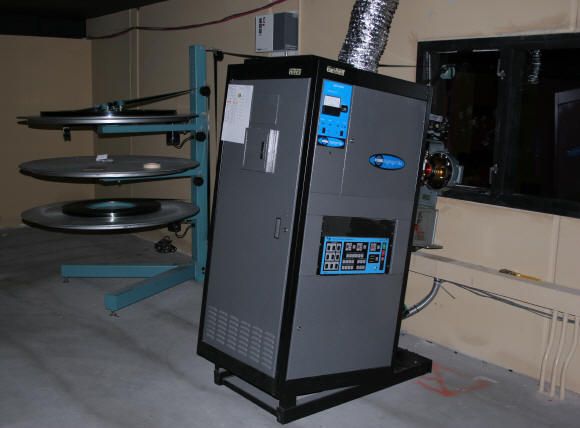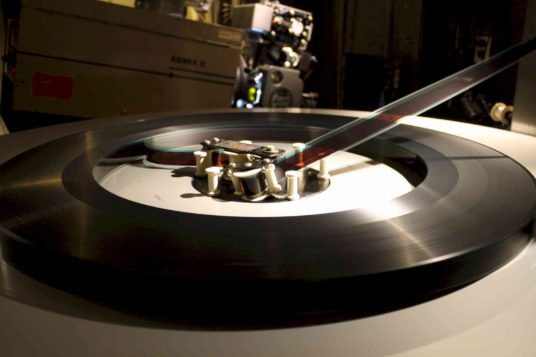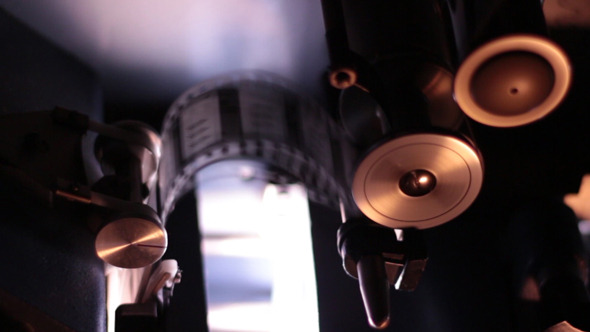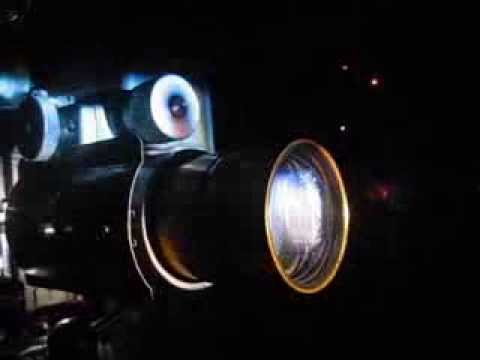 Without question, movie projection is a lost art. I say this as one who likes to see movies in theaters, projected on a big screen by a person who ideally knows what he or she is doing. My recent moviegoing, however, has convinced me that today’s projectionists are not the competent, knowledgeable professionals one might reasonably expect—far from it in fact!
Without question, movie projection is a lost art. I say this as one who likes to see movies in theaters, projected on a big screen by a person who ideally knows what he or she is doing. My recent moviegoing, however, has convinced me that today’s projectionists are not the competent, knowledgeable professionals one might reasonably expect—far from it in fact!
Please, spare me the violin solos about how difficult these guys have it. I was a projectionist once and so am fully aware most projectionists are paid very little, have less-than-ideal working conditions and must shoulder a far greater amount of responsibility than ground-level theater employees (if something goes wrong the projectionist has nobody to blame but him/herself). But it was also one of the easiest jobs I’ve ever held, and doing it right didn’t exactly tax my abilities.
For the record, my employment took place during the years 1992-94 at a six-screen multiplex. It was a fun job in many ways, with an excess of free time. This meant I was able to do my college homework while on the job, but also countless hours of boredom in the company of, essentially, six bratty, attention-craving children. The projectors I was in charge of were old and quite temperamental (they all had an irritating tendency to shut down suddenly for no fathomable reason, and had sound systems that were always malfunctioning in some way), so my job consisted largely of babysitting the things. Because of this I couldn’t ever leave the theater, and could only venture outside the projection booth–essentially a long hall with three projectors lined up on either side—sporadically. And all this for a whopping $5.90 an hour, slightly higher than the minimum wage at the time (but only slightly)!
In short, projecting movies can be a real pain in the ass, and I perpetrated some royal screw-ups during my two years on the job. Film breaks? Had ‘em. Film scratches? Made ‘em. Bad film splices? Done ‘em. (A bade splice, FYI, causes the picture to go out of frame and stay that way until the projectionist fixes it.) Mistakes threading up a projector? Yep. Forgot to dim the lights? Done that. Started a movie early/late? That too. Put on the wrong movie during a double bill? Likewise.
So I made many mistakes while projecting movies. But I did have pride in my work, and put forth a real effort to do the best job I could. This is  something I don’t believe is occurring with projectionists nowadays, who’ve screwed up in ways that seem careless and/or plain moronic…and the problems only seem to be getting worse.
something I don’t believe is occurring with projectionists nowadays, who’ve screwed up in ways that seem careless and/or plain moronic…and the problems only seem to be getting worse.
Let’s flash back to late ’95, shortly after I left the profession: An 8PM showing of CASINO at a So Cal multiplex was interrupted by a film break halfway through. Film breaks are fairly common, but easily fixable for any semi-experienced projectionist. I actually used to time myself, and got so I could fix a break and get a movie back up and running in a speedy three minutes. The idiots running that CASINO screening, on the other hand, took nearly an hour to do the same thing, stretching a three-hour movie to a hemorrhoid-inducing four and a half.
A year or so later came the afternoon MARS ATTACKS! screening in Westwood that was projected in the wrong aspect ratio. This is again something that’s easy to fix: Projectors have multiple lenses, one for the standard 1:33 ratio, one for the cinemascope 2:35 ratio, and another never-used one whose title and/or ratio I’ve forgotten. It was that third ratio that was in use during that MARS ATTACKS! experience (having the effect of compressing the image into a thin strip that ran across the center of the screen). This seemed to confuse the Hell out of the projectionist, who didn’t bother to change it.
I’d have been glad to do the honors myself, of course, but already knew that was a strict no-no. Because of insurance purposes, only the projectionist and managerial staff are allowed in the projection booth during business hours—when I was on the job I was told that if a customer should enter the booth, as did indeed happen on occasion, my first priority was to chase ‘em out ASAP.
 I did, however, try my damndest to convince the theater manager on that fateful afternoon that fixing the problem was doable simply by switching lenses (accomplished via a turret mechanism that spins and locks into position). The moronic manager simply stared back at me like I was speaking Latin. Long story short: I demanded a refund and took my business elsewhere.
I did, however, try my damndest to convince the theater manager on that fateful afternoon that fixing the problem was doable simply by switching lenses (accomplished via a turret mechanism that spins and locks into position). The moronic manager simply stared back at me like I was speaking Latin. Long story short: I demanded a refund and took my business elsewhere.
More stupidity was on the horizon. During an opening day screening of L.A. CONFIDENTIAL I was subjected to a). an hour-long wait for the damn thing to start (the film was late arriving), b). a film break, and c). a burned-out lamp. The lamp, as you might guess, is what lights the projector, and when it burns out the sound (governed by its own lamp) continues while the picture goes dark. Of course one would think the hour-long wait for the film to show up would have given the projectionist ample time to change the damn lamp. A dim projector lamp, I should add, is not terribly hard to spot—anyone paying the slightest attention can tell when the thing’s close to burning out (example: a dim-bulb screening of ETERNAL SUNSHINE OF THE SPOTLESS MIND that was so flickery I nearly had a seizure). The end result was another four-hour movie.
And there’s more! Recently I sat through a showing of the flick DISTURBIA that like that disastrous MARS ATTACKS! screening was marred by an incorrect aspect ratio. This time, however, it was the screen that was masked incorrectly. Movie screens, you see, are masked according to a movie’s aspect ratio: for a standard ratio movie they stay as they are, but for a scope film the screen is narrowed to fit the image.
In this particular case the screen was masked for a scope movie, yet DISTURBIA was projected in a standard 1:33 ratio, so a large portion of the top and bottom of the image were cut off. I went and complained to the manager, and was given that increasingly familiar puzzled expression. I assured him, as I assure you, that masking a screen is not at all difficult (in the theater I worked in it was done by simply pulling a chain). Of course if there are problems doing so, no worries: simply move the film to another screen! Since the theater in question was a sixteen-auditorium multiplex, I don’t think that’s an unreasonable request.
But all this pales in light of the most moronic screw-up of all, which occurred recently. It was during a screening of the anime flick PAPRIKA,  which again started around an hour late—as I understood it, the projectionist was still “building up” the film, meaning he was winding it from the reels sent by the issuing studio onto the platter from which it feeds into the projector. (It never took me over twenty minutes to build up, but never mind.) The screw-up took place in the fifth reel of the flick, which was wound and projected backwards, meaning it played upside down and in reverse order.
which again started around an hour late—as I understood it, the projectionist was still “building up” the film, meaning he was winding it from the reels sent by the issuing studio onto the platter from which it feeds into the projector. (It never took me over twenty minutes to build up, but never mind.) The screw-up took place in the fifth reel of the flick, which was wound and projected backwards, meaning it played upside down and in reverse order.
True, I’d long wondered what a backwards-loaded projection might look like; my projectionist superior once described it to me, but, never having been dumb enough to make that mistake, I never actually witnessed the spectacle. So on that day I finally got my chance watching PAPRIKA…but that did NOT make the experience any less annoying.
Fact: oftentimes the studio will deliver films to theaters with reels out of order. However, the beginning and ending of each reel are clearly marked, so if a reel is wound incorrectly one simply rewinds it onto a new reel, which takes around three to five minutes, and then adds the now-correctly wound film to the platter. Rocket science it isn’t!
Of course the above are just the most grievous examples of projectorial incompetence I’ve suffered. Others include garbled sound (not the projectionist’s fault, but easily fixable by switching to another channel—no, it may not be the five-channel stereo customers pay for, but it is better than having to listen to crappy sound)…too much sound of a most unwanted type emanating from the projection booth (in my day radios and TVs were strictly barred from the booth, but modern day theater managers are evidently more lax)…misframing (a screening of THE CONSTANT GARDENER looked like SLEEPY HOLLOW, as everybody’s head was cut off)…unclean projection windows (the glass through which the film is projected has to be periodically scrubbed or else dust builds up and you get a fuzzy picture, as I’ve witnessed many times)…and lots more problems.
I’ve never pretended to be an expert on the art of projecting movies, but based on all the bad projection I’ve experienced, I’ll admit I’m now feeling like one. In the end, though, I’m just like anyone else: a guy who likes to see movies. But with all these projection problems I’ll admit I’m finding the experience increasingly less enjoyable than I once did!
